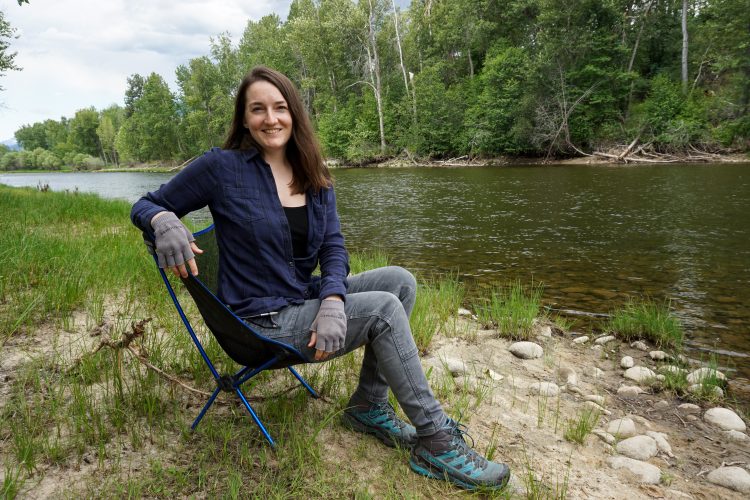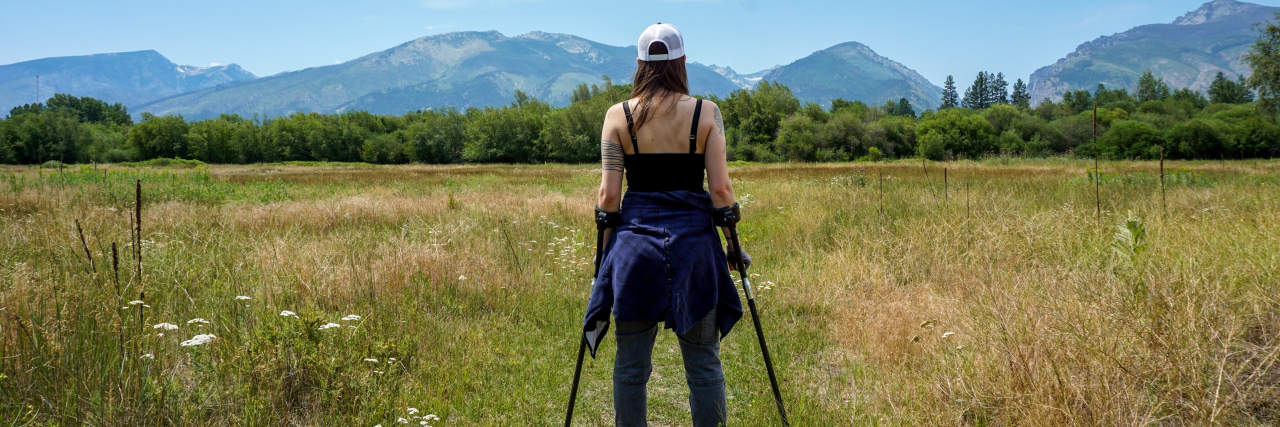Some non-disabled folks enjoy outdoor recreation, and some people with chronic illness and disabilities want to explore the outdoors too! Our limitations may look different and we may require a little extra planning and recovery time, but if we take the right steps to support our bodies, we can still enjoy being in nature. Here are my top five tips for exploring the outdoors with chronic illness and disabilities.
1. Preparation and Planning
Before you go on your adventure, collect as much information as you can on the place you are planning to visit, like trail descriptions and reviews. That way you might know what to expect and can plan accordingly. For example, if people are commenting on the bumpy roads, you’ll know to bring nausea medication, or to bring a lightweight, portable chair if there are no benches. Preparing ahead of time can make for a better trip with fewer discomforts.

You also want to have a backup plan. It can be really frustrating to drive two hours, get carsick, cause a flare up, just to show up and find a road is closed or a river flooded or any number of unforeseen circumstances. So wherever you’re planning to go, search for one or two backup options in the area just in case plan A falls through. That way you’re not sitting there with all the brain fog and no cell service trying to find somewhere else to go.
I would also recommend having all of this information available on your phone offline. Screenshot the relevant information and download offline maps of the entire area, so you don’t have to fight with your brain to remember everything you read, and you can reference that information as many times as needed.
2. You Do Not Have to Conquer a Mountain
Many chronically ill and disabled outdoor lovers were once “healthy,” able-bodied outdoor lovers, and it can be difficult to accept that our adventures no longer look like they once did. Because of this, some of us will stop doing outdoor activities altogether. But it is not 10-mile hikes or nothing, and you do not need to “conquer” a mountain to enjoy the outdoors.
Outdoor recreation doesn’t have to be some adrenaline rush or feat of strength like whitewater rafting or rock climbing. Try wandering around a state park taking pictures of flowers, bring binoculars to watch the birds at a wildlife refuge, or sit by the river and listen to the flowing water while you watch the trees sway in the wind. It’s OK to slow down, be gentle with your body, and just enjoy being in nature. It’s OK to just be.
3. Use the Damn Mobility Aid!
That mobility aid you’ve been wondering about whether or not it would help you? Try it! Use it! You don’t need anybody’s permission or approval to start using a mobility aid. If you feel it’s something that would help reduce pain and fatigue, or increase stability and balance, then it’s worth trying. And no, you’re not being dramatic or faking. You are deserving of whatever relief and assistance the aid could provide, no matter your age or diagnosis.
Mobility aids are not a negative thing, they are a tool for supporting your body. If they aid you in living your life more fully and reduce the impact of symptoms during or after your adventures, then it’s worth it. Mobility aids can mean freedom and improved quality of life for a lot of people. Whether it’s a wheelchair, crutches, cane, walker, rollator, or trekking poles, support your body the way it needs to be supported. You’ll be able to do more, and you’ll have a much better time doing it.
4. Rest and Take Breaks
While you’re out adventuring, plan to rest. Take breaks! It can be every hour, every half hour, for five minutes, or 10 or 20 — whatever works for you and whatever your body needs. By pacing yourself and letting your body rest periodically, you’ll be able to better manage your symptoms and stay out longer. You may even be able to reduce the intensity of the inevitable flare up afterwards.
Taking breaks doesn’t have to be a bad thing. We can use it as an opportunity to really take in the view and enjoy the scenery. It’s also quite special when you visit a place and feel comfortable enough to sit down or lay down and rest. How beautiful to feel so connected to a place in nature that you feel as at home sitting here as you would on the couch in your own home. This is an opportunity to experience something new: lean into it! You are safe here. Rest and let nature hold you.
5. Recovery
Remember that learning to live well with illness and disabilities is not about fighting our body’s needs every step of the way and expecting to do and feel exactly as a “healthy,” abled person. Sometimes, it doesn’t matter how careful we are or that we did all the right things, sometimes our symptoms flare up anyway. Plan for it!
Expect a several day recovery period after a big adventure and block off a few days in your calendar. Chores can wait. Your to-do list can wait. Support your body however you can. Do some gentle stretches, massage your muscles, take a bath, curl up in a blanket. As much as you enjoyed yourself on your adventure, offer the same dedication and gentle tender loving care to your body while you rest and recover.
It is still possible to enjoy the outdoors with chronic illness and disabilities. It might look a little different than it used to or in comparison to others, but it’s not 10-mile hikes or bust. We can find a balance between doing the things we love to do and living well with illness and disability. So plan and prepare beforehand, support your body, take breaks, and be gentle with yourself after.
Take good care of you, everyone!
Images via contributor

